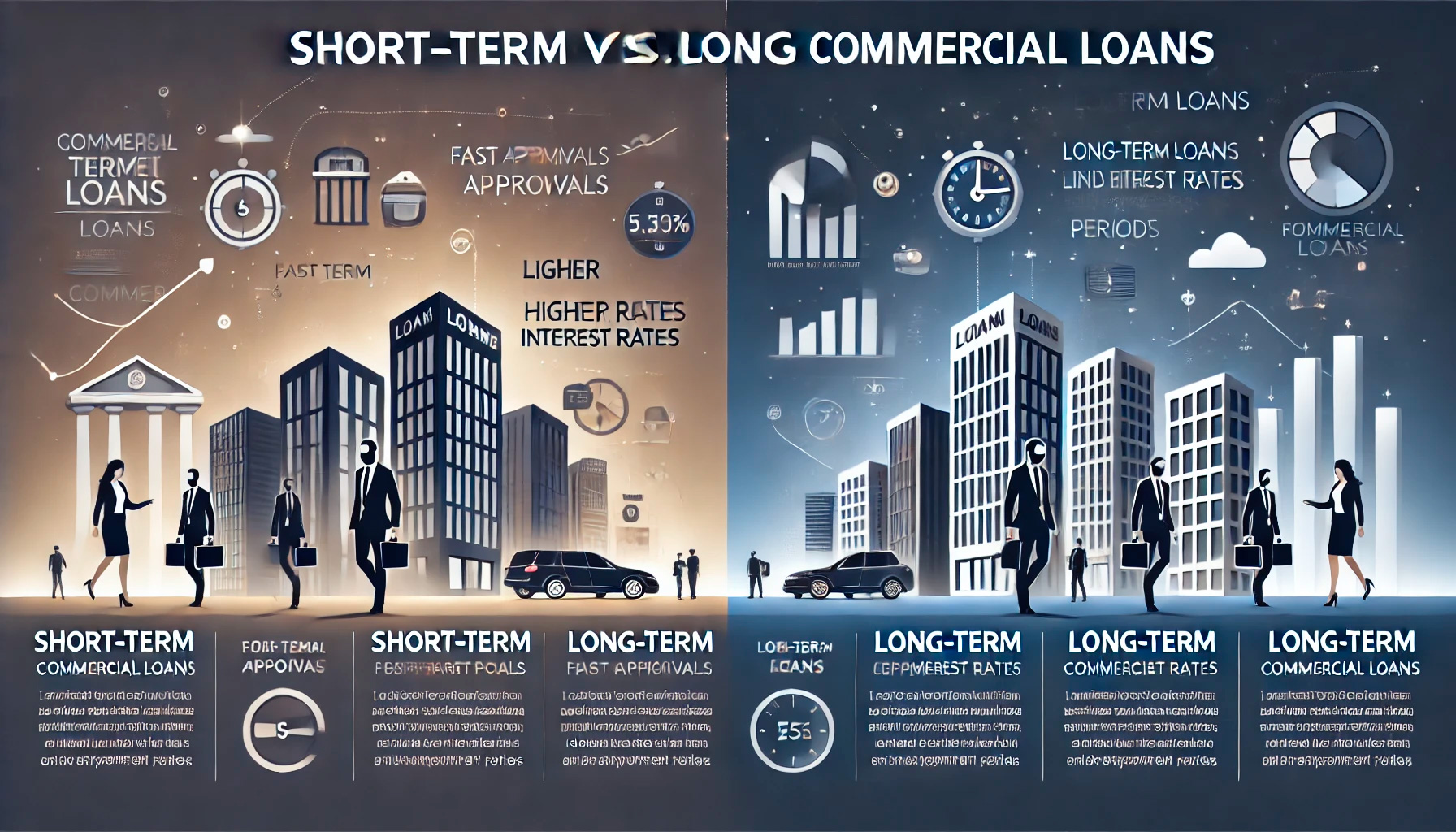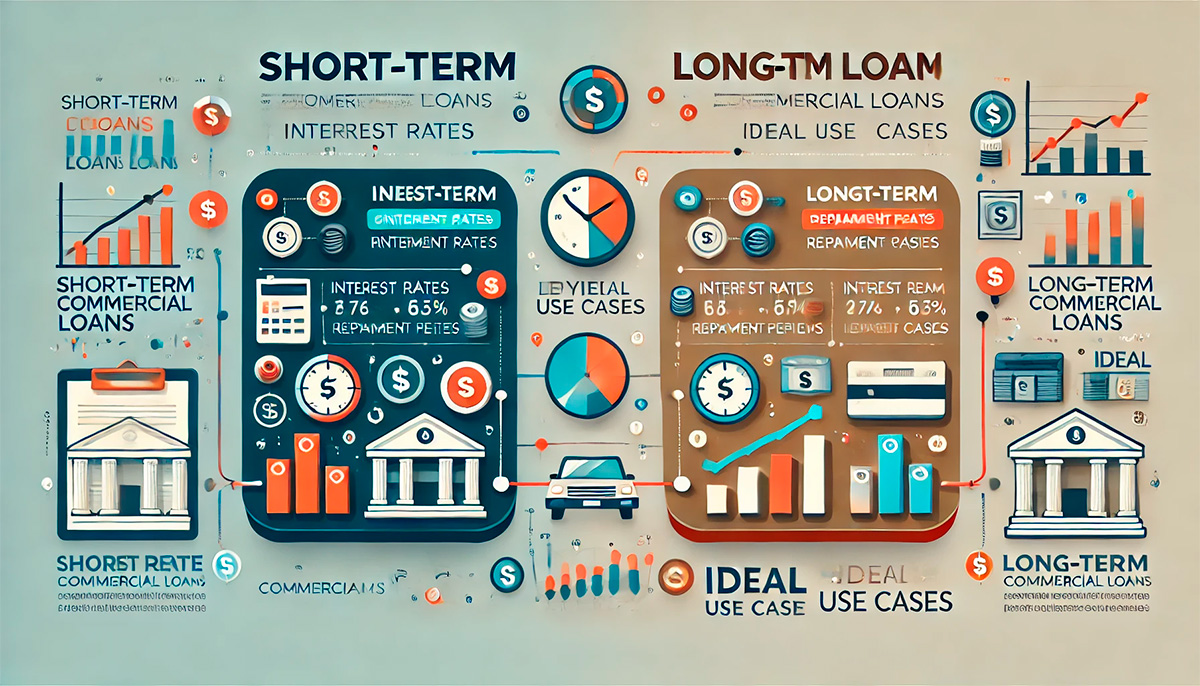
Short-Term vs. Long-Term Commercial Loans: Which Is Right for Your Business?
For business owners, securing the right type of financing is often the key to achieving growth and maintaining stability. Whether you need capital to address immediate needs or fund a long-term project, choosing between short-term and long-term commercial loans is a critical decision. Each option serves distinct purposes and comes with unique advantages and challenges. This guide explores the differences between short-term and long-term commercial loans, helping you determine which is best suited for your business goals.
What Are Short-Term Commercial Loans?
Short-term commercial loans are designed to provide businesses with quick access to capital, typically to address immediate financial needs. These loans usually have repayment terms ranging from a few months to a maximum of three years. The funds are often used for purposes such as managing cash flow, purchasing inventory, or covering unexpected expenses.
The primary appeal of short-term loans lies in their speed and accessibility. Lenders often have streamlined application processes, enabling businesses to receive funds within days. However, the convenience of short-term loans comes with higher interest rates and shorter repayment periods, which can lead to larger monthly payments.
What Are Long-Term Commercial Loans?
Long-term commercial loans, on the other hand, are structured to support significant investments or projects that require substantial funding. These loans typically have repayment terms spanning several years, sometimes extending up to 25 years or more. They are often used for purchasing real estate, acquiring expensive equipment, or financing large-scale expansion projects.
Long-term loans offer lower interest rates and more manageable monthly payments compared to short-term options. However, the application process can be more rigorous, requiring detailed financial documentation and a strong credit history. While they provide stability and predictability, long-term loans also involve a prolonged financial commitment.

Key Differences Between Short-Term and Long-Term Loans
The fundamental differences between short-term and long-term loans lie in their repayment terms, interest rates, and intended purposes.
Short-term loans are ideal for businesses needing immediate cash for time-sensitive expenses. The higher interest rates are balanced by the short repayment period, ensuring that the debt is cleared quickly. Long-term loans, in contrast, are better suited for funding significant investments that will generate returns over an extended period. Their lower interest rates and smaller monthly payments make them a more affordable option for large-scale projects.
Another distinction is the level of financial scrutiny involved. Short-term loans often have simpler application processes and are accessible to businesses with average credit profiles. Long-term loans, however, require thorough evaluation, including detailed financial statements, revenue projections, and often collateral.
Advantages of Short-Term Commercial Loans
Short-term loans offer several benefits that make them a valuable resource for businesses needing immediate financial support.
One of their most significant advantages is speed. When faced with unexpected expenses or opportunities, businesses can secure short-term loans quickly, ensuring they remain agile in dynamic markets. Additionally, the shorter repayment period reduces the long-term financial burden, allowing businesses to free up capital sooner.
These loans are also flexible in their use, making them suitable for a variety of needs, from purchasing seasonal inventory to bridging cash flow gaps. For small businesses or startups, short-term loans provide an accessible way to address immediate challenges without committing to long-term debt.
Advantages of Long-Term Commercial Loans
Long-term loans excel in providing stability and affordability for businesses pursuing significant investments. Their lower interest rates make them a cost-effective choice for financing expensive assets, such as real estate or machinery, that generate returns over many years.
The extended repayment period reduces the strain on monthly cash flow, enabling businesses to allocate funds to other priorities. This predictability allows for better financial planning and supports long-term growth strategies.
Another advantage is the potential for building equity. For example, businesses using long-term loans to purchase property can benefit from property appreciation over time, creating a valuable asset while meeting their operational needs.

Choosing the Right Loan for Your Business
The decision between a short-term and long-term loan depends on your business’s specific needs, goals, and financial situation. Assessing these factors will help you make an informed choice that aligns with your objectives.
If your business requires immediate funding to address a short-term challenge, such as covering payroll or managing unexpected repairs, a short-term loan is likely the better option. Its quick approval process and flexibility ensure you can address urgent needs without delay.
For businesses planning significant investments, such as opening a new location or acquiring costly equipment, a long-term loan offers the stability and affordability needed to achieve these goals. The lower monthly payments and extended timeline reduce financial pressure, allowing you to focus on generating returns from your investment.
Key Considerations Before Applying
Before committing to either type of loan, it’s essential to evaluate your financial position and repayment capacity. Start by reviewing your cash flow, credit history, and existing obligations to determine how much you can comfortably borrow and repay.
Additionally, consider the purpose of the loan and how it aligns with your business goals. For short-term needs, ensure the investment will generate immediate returns or resolve pressing issues. For long-term loans, evaluate the potential return on investment and whether the project will contribute to your business’s growth and sustainability.
It’s also wise to compare offers from multiple lenders. Interest rates, fees, and terms can vary significantly, so researching and negotiating with different lenders can help you secure the most favorable deal.
Conclusion: Finding the Balance
Both short-term and long-term commercial loans play essential roles in supporting businesses at different stages and for various purposes. By understanding their unique advantages and limitations, you can select the option that best suits your business needs.
Short-term loans provide the agility and speed needed to address immediate challenges, while long-term loans offer the stability and affordability required for significant investments. Whether you’re managing cash flow, pursuing growth opportunities, or navigating unexpected expenses, the right loan can empower your business to thrive.
Careful planning, thorough research, and a clear understanding of your goals will ensure that your chosen loan aligns with your financial strategy, setting the foundation for lasting success. With the right financing in place, your business can confidently move forward and seize new opportunities in an ever-changing market.
